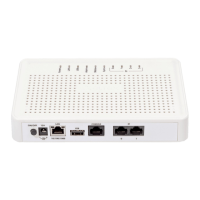SMG digital gateway 189
10 APPENDIX F. DEVICE INTERACTION WITH MONITORING SYSTEMS
To enable real-time fault monitoring for the device, configure device interaction with a monitoring
system.
Absence of faults means device normal operation; when a fault event occurs, the normal state turns to
the alarm state, when all the current faults are resolved, the normal operation state is restored.
Possible indications of device status:
front panel light indication—Alarm LED (for Alarm LED indication, see section 1.6 LED Indication);
indication of the most critical failure in the header of web interface (see operation log for more
details);
transmission of the fault events to the monitoring system via the SNMP protocol (trap, inform).
Events for the fault state generation are divided into unconditional and optional:
Unconditional—faults with non-configurable indication; they include:
– CONFIG—a critical fault, a configuration file fault;
– SIPT-MODULE—a critical fault, a failure of a software module responsible for VoIP
operation;
– SM-VP DEVICE—a fault, an SM-VP IP submodule failure;
– SYNC—a fault indicating that a synchronisation source is missing or a warning indicating
that synchronisation is performed with a low-priority synchronisation source;
– CDR-FTP—a critical fault or a warning indicating an error during CDR data transfer to the
FTP server; the fault level is determined by the amount of CDR data awaiting transfer to
the server;
– TRANSIT – critical alarm, which occurs in case of error while semi-permanent connection
establishment for E1 channel transit.
Optional—faults with configurable indication; they include:
– STREAM—a critical fault, an E1 stream is not in operation;
– STREAM-REMOTE—a warning, a remote fault of an E1 stream;
– STREAM-SLIP—a warning, SLIPs in a stream;
– These faults are configured in physical parameters of E1 streams (see section 4.1.2.2).
– LINKSET—a critical fault, an SS-7 line group is not in operation;
– SS7LINK—an SS-7 signal channel failure;
– SIP-ACCESS—an availability fault of an opposite gateway via the SIP interface;
– CPU-OVERLOAD—a CPU load failure;
– MEMORY-LIMIT—a failure, no free RAM;
– DRIVE-LIMIT—a failure, no free space on an external drive.
By default, optional fault indication is disabled, i. e. interaction with monitoring systems requires
configuration of failure indication for all necessary objects.
To configure interactions with monitoring systems via SNMP, enable SNMP on the device and configure
SNMP TRAP or INFORM message transmission to the monitoring server IP address.
Configuration via Web Configurator
1) Configuration of optional failure indication for an Е1 stream (the E1 Stream/Physical Parameters menu, see
section 4.1.5.2 Configuration of Physical Parameters).

